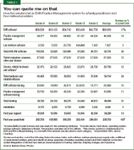Avoiding EHR sticker shock
Here's how to dissect EHR bids to make sure you're getting the best deal.

Key Points
Shopping for an electronic health record (EHR) system can be an unpleasant surprise. It happens when you hear a quote for EHR software-say $13,000 per provider-and forget that software constitutes just one slice of the total cost. Hardware, training, and support represent the lion's share of the first-year sticker price, which includes charges you never dreamed of-like thousands for software to connect your new system to a laboratory computer. Suddenly a $13,000 quote buds an extra zero.
Confusion follows when you compare quotes from multiple vendors. Why is the highest quote more than double the lowest? Why do some vendors charge more for EHR training than for software?

We asked Drury to tell the story behind the numbers in these IT quotes, and we've gleaned additional insights from computer consultant Rosemarie Nelson in Syracuse, NY. Their comments illuminate an often murky subject.
Why EHR programs come with different price tags

Why the big spread? After all, each quote theoretically satisfied the "request for proposal" that Drury submitted to the five vendors on behalf of the Alaska doctor (see "How to do an RFP for an EHR," in the Jan. 19, 2007 issue of Medical Economics, at http://www.memag.com/). In other words, each system was supposed to give the FP the same functionality.
EHR software prices vary for a number of reasons, says Drury. Consider the wild card called "midlevel provider," for example. Vendors typically charge for one-time software licenses on a per-doctor basis, but how they count midlevels-the Alaska FP employs four-differs from company to company. "Some of the vendors charged as much for midlevels as they did for physicians, while others discounted the price up to 40%," says Barbara Drury.
Another wildcard is a vendor's business circumstances. "If a software company makes most of its money selling to hospitals with generous IT budgets, it might be able to afford to drop its prices for doctors," says consultant Rosemarie Nelson. "And a privately held company may be on the low side to boost sales so it can attract venture capital."
